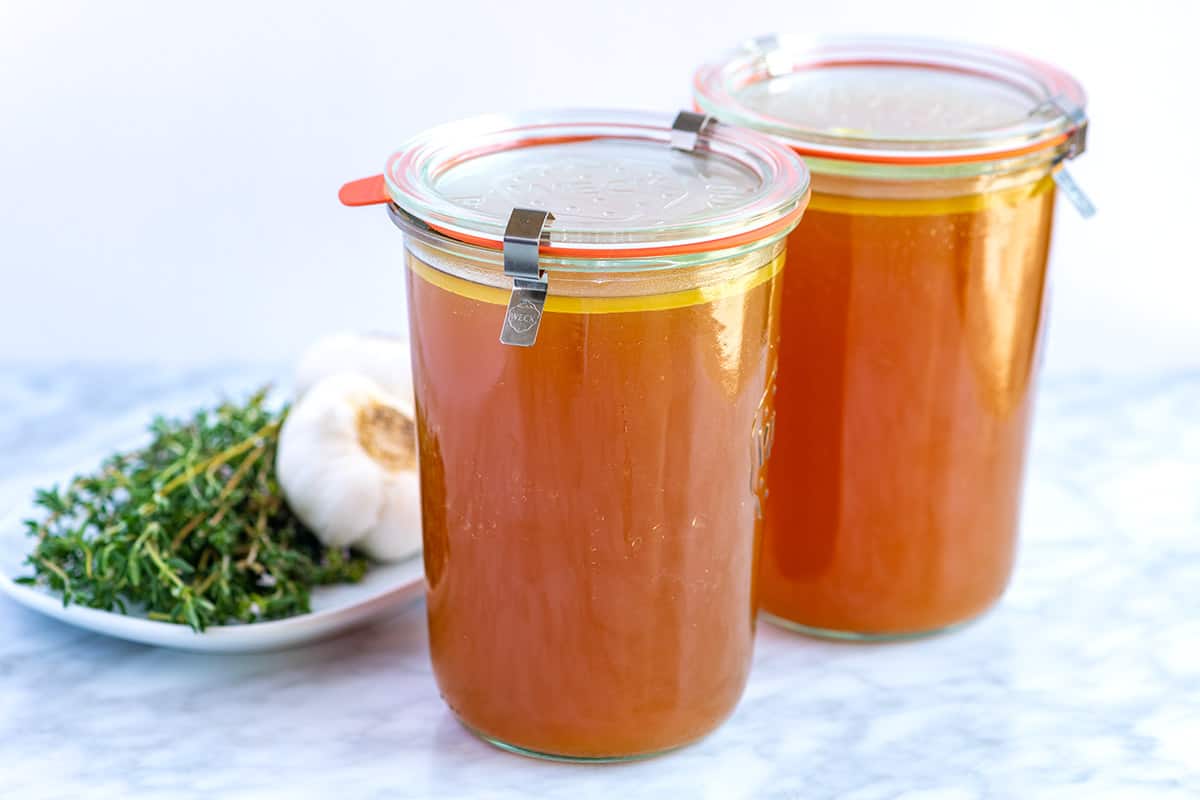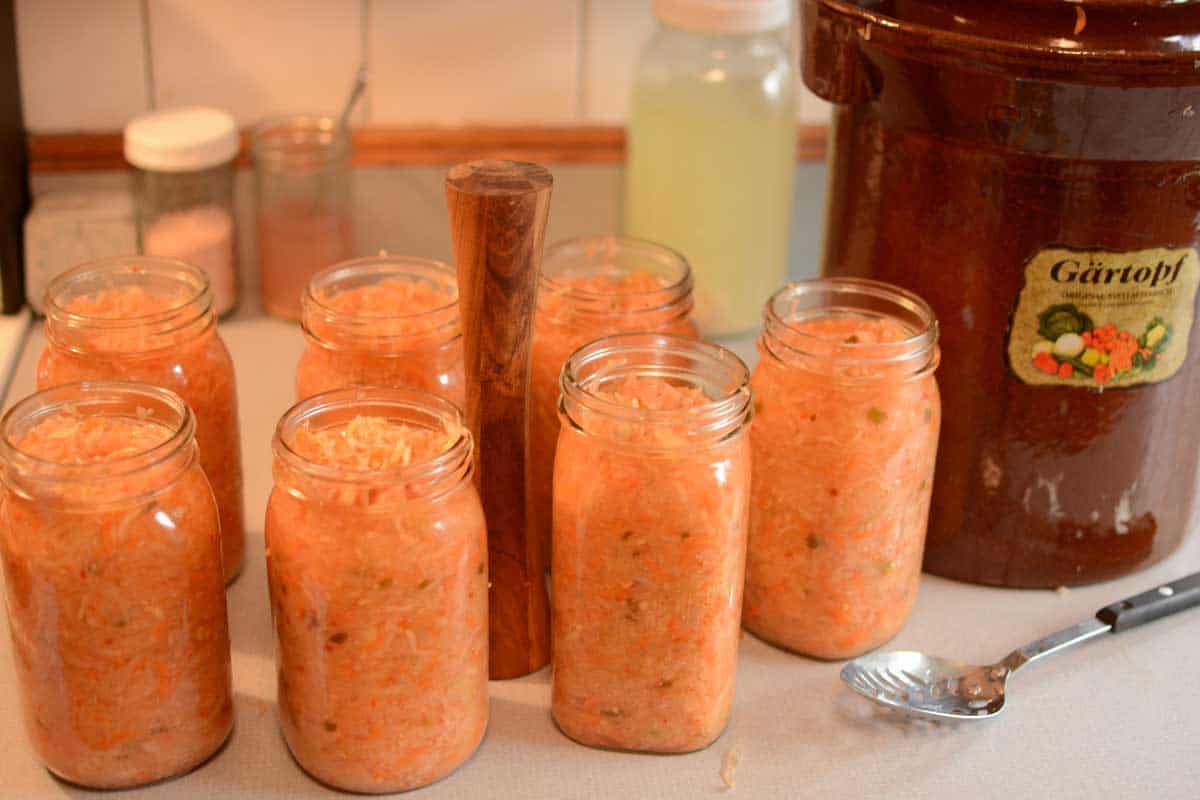

Articles
How To Store Homemade Stock
Modified: February 24, 2024
Discover efficient and practical methods to store your homemade stock with our informative articles. Ensure freshness and extend the shelf life of your delicious stock.
(Many of the links in this article redirect to a specific reviewed product. Your purchase of these products through affiliate links helps to generate commission for Storables.com, at no extra cost. Learn more)
Introduction
Welcome to the world of homemade stock! If you’re someone who loves to cook and experiment with flavors, making your own stock is an essential skill to master. The rich and aromatic liquid that is the result of simmering bones, vegetables, and herbs is a key ingredient in countless recipes, adding depth and complexity to dishes.
However, once you’ve put in the effort to make a batch of homemade stock, it’s important to store it properly to ensure it stays fresh and safe to consume. In this article, we’ll explore the reasons why homemade stock needs proper storage, the basic principles of storing it, and provide you with a step-by-step guide to help you store your stock effectively.
So why does homemade stock require special attention when it comes to storage? The answer lies in its perishable nature. Unlike store-bought stocks that often contain preservatives, homemade stock typically lacks these additives, making it more susceptible to spoilage if not stored correctly.
Additionally, homemade stock is often made in large batches, meaning you’ll likely have more than you need for one recipe. Proper storage ensures that you can store leftover stock safely for extended periods, allowing you to use it in future dishes and avoid waste.
The basic principles of storing homemade stock revolve around three key factors: temperature, container choice, and hygiene practices. Let’s delve into each of these in more detail.
Key Takeaways:
- Proper storage of homemade stock is crucial for maintaining its safety, flavor, and quality. By following the right practices, you can make the most of your stock and enhance your culinary creations.
- Avoid common mistakes such as improper cooling and using the wrong containers to ensure your homemade stock remains safe, flavorful, and ready to enhance your culinary creations.
Read more: How To Store Stockings
Why Homemade Stock Needs Proper Storage
Proper storage is crucial when it comes to homemade stock due to its perishable nature. Here are a few key reasons why you should pay special attention to storing your homemade stock:
- Preventing bacterial growth: Homemade stock is made from animal bones, vegetables, and herbs, providing an ideal environment for bacterial growth if not stored properly. To ensure the safety of your stock, it’s essential to store it in a way that inhibits the growth of harmful bacteria.
- Maintaining flavor and quality: Homemade stock is known for its rich, flavorful taste. However, if exposed to improper storage conditions, the flavors can deteriorate, leading to a less enjoyable culinary experience. By storing your stock correctly, you can maintain its quality and ensure it retains its delicious taste.
- Minimizing waste: Making homemade stock often involves a significant investment of time and ingredients. To make the most of your efforts and resources, it’s important to store any leftover stock properly, enabling you to use it in future recipes without wastage.
- Extended shelf life: Proper storage practices can help extend the shelf life of homemade stock. By keeping it in optimal conditions, you can ensure it stays fresh for a longer period, allowing you to enjoy its flavors over time.
- Budget-friendly: Homemade stock is a cost-effective alternative to store-bought options. By storing it correctly, you can make the most of your homemade stock, avoiding the need to purchase expensive store-bought alternatives.
Overall, proper storage of homemade stock is essential for maintaining its safety, flavor, and quality. By following the right practices, you can make the most of your stock and enhance your culinary creations.
Basic Principles of Storing Homemade Stock
When it comes to storing homemade stock, there are a few basic principles to keep in mind. Following these principles will help maintain the freshness, flavor, and safety of your stock:
- Cooling: After you’ve finished making your homemade stock, it’s essential to allow it to cool down before transferring it to storage containers. Placing hot stock directly into the refrigerator can raise the temperature of the fridge, potentially compromising the safety of other perishable foods. Let the stock cool on the countertop for 30 minutes to an hour before transferring it.
- Refrigeration or freezing: Two main options for storing homemade stock are refrigeration and freezing. Stock stored in the refrigerator is best consumed within 3 to 4 days, while frozen stock can last for several months. Consider the quantity you have and how quickly you plan to use it when deciding between refrigeration and freezing.
- Container choice: Selecting the right container is crucial for storing homemade stock. Use airtight containers that are specifically designed for storing liquids. Mason jars, plastic containers, or food-grade storage bags work well. Make sure the containers are clean and free from any residue or odors that can transfer to the stock.
- Portioning: It’s a good idea to store your homemade stock in small portions rather than one large container. This allows you to use only what you need when cooking without having to thaw or heat the entire batch. It can be helpful to freeze stock in ice cube trays or small freezer bags for easy portioning.
- Labeling: Properly label your containers with the date of preparation. This will help you keep track of when the stock was made and ensure you use the oldest stock first.
- Hygiene practices: Maintain good hygiene practices when handling and storing your homemade stock. Wash your hands thoroughly before transferring the stock to containers or handling storage bags. Ensure all containers and utensils used are clean to prevent any contamination.
By following these basic principles, you can ensure your homemade stock stays fresh, flavorful, and safe to consume. It’s time to move on to the next section and learn the step-by-step guide to storing your homemade stock.
Step-by-Step Guide to Storing Homemade Stock
Now that you understand the importance of proper storage for homemade stock, let’s walk through a step-by-step guide to help you store your stock effectively:
- Cool the stock: Allow your homemade stock to cool down to room temperature after cooking. This usually takes around 30 minutes to an hour. This step is crucial to prevent the transfer of heat to your refrigerator or freezer, potentially affecting other perishable items.
- Select your storage containers: Choose appropriate containers that are airtight and specifically designed for storing liquids. Mason jars, plastic containers, or food-grade storage bags are all suitable options. Make sure the containers are clean and free from any residue or odors.
- Spoon off fat (optional): If there is a layer of fat on top of your stock, you may choose to remove it before storage. This can be done by gently skimming off the fat with a spoon. However, some people prefer to leave the fat intact, as it can add flavor and act as a protective barrier for the stock.
- Portion the stock: Divide the stock into small portions to make it easier to use in future recipes. This can be done by pouring the stock into smaller containers or using ice cube trays or freezer bags for convenient portioning. Leave some headspace in the containers to allow for expansion when freezing.
- Label and date: Properly label each container with the date of preparation. This will help you keep track of the freshness of your stock and use the oldest stock first.
- Refrigeration or freezing: Depending on your intended use and timeline, decide whether to store the stock in the refrigerator or freezer. Refrigerated stock should be consumed within 3 to 4 days, while frozen stock can be stored for several months.
- Store in the refrigerator: If you plan to use the stock within a few days, place the containers in the refrigerator. Make sure they are tightly sealed to prevent any contamination or absorption of odors from other food items.
- Freeze the stock: If you don’t plan on using the stock within a few days, transfer the containers to the freezer. Ensure they are placed on a flat surface to allow for even freezing. For faster thawing and portioning, freeze in smaller containers or use ice cube trays.
- Thawing frozen stock: When you’re ready to use frozen stock, transfer the container(s) to the refrigerator and let them thaw overnight. You can also use the defrost setting on your microwave for quicker thawing, but be cautious not to overheat the stock.
- Check for quality: Before using any stored stock, check for any signs of spoilage such as off smells, unusual colors, or the presence of mold. If you notice any abnormalities, discard the stock immediately.
By following these step-by-step instructions, you can ensure that your homemade stock is stored properly and ready to be utilized in your favorite recipes, bringing rich and flavorful goodness to your meals.
Store homemade stock in airtight containers or resealable bags in the refrigerator for up to 4 days, or freeze it for up to 3 months for future use. Label and date the containers for easy reference.
Tips for Maximizing Shelf Life of Homemade Stock
To make the most of your homemade stock and ensure it stays fresh for as long as possible, here are some valuable tips for maximizing its shelf life:
- Proper cooling: Allow your homemade stock to cool down completely before transferring it to storage containers. Rapidly cooling down hot stock can lead to condensation, which can introduce moisture and potentially affect the longevity of your stock.
- Airtight storage: Ensure your storage containers are airtight to prevent any air exposure. Oxygen can cause stock to degrade faster and can lead to off flavors. Use containers with tight-fitting lids or sealable bags specifically designed for food storage.
- Control temperature: Refrigerate or freeze your stock promptly after it has cooled down. Keeping it at a controlled temperature is crucial for maintaining freshness. Store refrigerated stock at a temperature below 40°F (4°C) and frozen stock at 0°F (-18°C) or below.
- Use smaller containers: Consider storing your stock in smaller portions rather than one large container. This allows you to thaw and use only the amount you need without exposing the entire batch to repeated temperature changes.
- Rotate your stock: When using stored stock, be mindful of using the oldest containers first. This practice ensures that none of your stock goes unused for too long, minimizing the risk of spoilage.
- Frozen stock protection: If using freezer bags, consider placing them in a rigid container or plastic box for added protection against freezer burn and potential leaks. This will help maintain the quality of your stock during freezing and prevent cross-contamination in case of any spills.
- Label with expiration date: Apart from labeling with the date of preparation, write the expiration date on the containers. While stock can remain safe to consume for an extended period, it’s helpful to have a reference for freshness.
- Keep track of storage time: Maintain a record of how long each batch of stock has been stored. This can help you track the shelf life and ensure you use it within a reasonable time frame.
- Quality checks: Before using stored stock, inspect it for any signs of spoilage, such as off smells, discoloration, or unusual textures. If anything seems off, it’s best to discard the stock to prevent any potential foodborne illnesses.
- Consider canning: If you have experience with canning and want to extend the shelf life of your homemade stock even further, consider pressure canning it. This method can provide long-term storage at room temperature, but it requires proper equipment and knowledge of safe canning practices.
By implementing these tips, you can help maximize the shelf life of your homemade stock, ensuring that it stays fresh and flavorful for as long as possible.
Common Mistakes to Avoid When Storing Homemade Stock
While storing homemade stock may seem straightforward, there are some common mistakes that can compromise its quality and safety. Here are some key mistakes to avoid:
- Not cooling the stock properly: Failure to cool your homemade stock adequately before storing it can lead to the growth of bacteria and spoilage. Make sure to allow the stock to cool at room temperature for a sufficient amount of time before transferring it to the refrigerator or freezer.
- Using improper storage containers: Choosing the wrong containers for storing your stock can result in leaks, odors, or contamination. Avoid using containers that are not designed for liquids or those that do not provide airtight seals. Ensure your chosen containers are clean, food-grade, and properly sealable.
- Overfilling storage containers: Filling your storage containers to the brim can cause them to burst when frozen, leading to a messy and wasteful situation. Leave some space at the top of the containers to allow for expansion during freezing.
- Not labeling and dating: Neglecting to label and date your stock containers can lead to confusion and potential spoilage. Properly label each container with the date of preparation to ensure you use the oldest stock first.
- Storing stock at incorrect temperatures: Failing to store stock at the appropriate temperature can accelerate spoilage. Refrigerated stock should be kept below 40°F (4°C), while freezer temperature should be maintained at 0°F (-18°C) or below.
- Thawing and refreezing stock: Thawing and refreezing stock multiple times can negatively impact its quality and safety. It’s best to portion your stock into smaller containers to avoid the need for repeated thawing and refreezing.
- Ignoring expiration dates: Homemade stock, like any other perishable food item, has a limited shelf life. Ignoring expiration dates and using stock that has been stored for too long can lead to potential health risks. Keep track of storage times and prioritize using older stock first.
- Not inspecting stock before use: Failing to check for signs of spoilage before using your stored stock can result in consuming potentially unsafe food. Always inspect the stock for any off smells, unusual colors, mold, or other indications of spoilage. When in doubt, discard the stock.
- Leaving stock in the refrigerator for too long: Homemade stock stored in the refrigerator should be used within 3 to 4 days. Leaving it for longer periods can increase the risk of bacterial growth and spoilage. Freeze any stock that you don’t plan to use within this timeframe.
- Not protecting frozen stock: Frozen stock can be damaged by freezer burn if not properly protected. Ensure that your containers or bags are airtight and consider using an additional layer of protection, such as placing freezer bags in a rigid container, to prevent freezer burn and maintain quality.
By avoiding these common mistakes, you can ensure that your homemade stock remains safe, flavorful, and ready to enhance your culinary creations.
Conclusion
Proper storage of homemade stock is essential to maintain its freshness, flavor, and safety. By following the basic principles and tips outlined in this article, you can ensure that your homemade stock is stored correctly and ready to be used in your favorite recipes.
Cooling the stock before storage, selecting appropriate containers, and portioning the stock are important steps to consider. Labeling and dating your containers, as well as practicing good hygiene, can help you keep track of your stock and maintain its quality.
Refrigeration and freezing are two main storage options depending on your needs and timeline. While refrigerated stock should be used within a few days, freezing allows you to store stock for extended periods, maximizing its shelf life.
Avoiding common mistakes such as improper cooling, using the wrong containers, and ignoring expiration dates is crucial for maintaining the safety and quality of your stock. Regularly inspecting stock for signs of spoilage and ensuring proper storage temperatures will further safeguard against any issues.
Remember, homemade stock is a valuable culinary asset, enhancing the flavors of your dishes and saving you money compared to store-bought options. With proper storage techniques, you can make the most of your homemade stock, minimizing waste and elevating your cooking to new heights.
So, the next time you make a batch of flavorful homemade stock, take the time to store it properly and enjoy the benefits of having this versatile ingredient at your fingertips whenever you need it.
Frequently Asked Questions about How To Store Homemade Stock
Was this page helpful?
At Storables.com, we guarantee accurate and reliable information. Our content, validated by Expert Board Contributors, is crafted following stringent Editorial Policies. We're committed to providing you with well-researched, expert-backed insights for all your informational needs.















0 thoughts on “How To Store Homemade Stock”